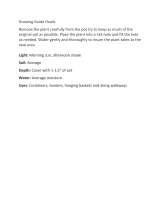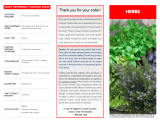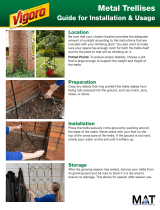Page is loading ...

*Image on cover is representative of the type of plant(s) in this offer
and not necessarily indicative of actual size or color for the included
variety.
Muscadines are fruiting vines native to the
southeastern United States. Ripening in late
summer, they bear an abundance of delicious
thick-skinned fruits with soft, juicy centers. These
unique grape-like fruits are ideal for making jam,
jellies, and wines, or for simply eating fresh from
the vine.
Caution: Do not assume any plant is safe to
eat. Only parts of plants expressly grown to
be eaten should be considered edible. As
with any product that is not food, care should
be taken to make sure that small children and
pets do not ingest any part of a plant that is
not expressly grown to be eaten.
Unless specifically stated, this product is intend-
ed for ornamental horticultural use only and is
not intended for consumption or ingestion by
humans or pets. Most plants are harmless but
some contain toxic substances which can cause
adverse health effects. Furthermore, some indi-
viduals and some animals are sensitive or allergic
to certain plants and precautions should be taken
to limit or avoid physical contact with particular
plants. Some plants have thorns or spines that can
be painful if handled.
In case of ingestion contact a poison
control center immediately.
1-800-222-1222
Full sun.
LIGHT/SUN
EXPOSURE
USDA HARDINESS
ZONES
PLANTING
DISTANCE
IN-GROUND
MATURE SPREAD
Up to 20 feet long.
Spring.
Edible fruit.
Berries ripen in midsummer.
Great for cooking or eating fresh.
BLOOM TIME
TIME TO REACH
MATURITY
FACTS OF NOTE
PLANT TYPE
Perennial.
CONTAINER SIZE
One plant per 12-inch or larger
container.
12 to 24 months.
QUICK REFERENCE PLANTING GUIDE
Thank you for your order!
7 to 10.
At least 10 feet apart.
SOIL PREPARATION
We recommend having your soil tested periodically by
your local County Extension Office (www.nifa.usda.gov/
extension or by calling 1-800-333-4636). A soil test can
determine if your soil needs any amendments to enhance
the growth and performance of your plants.
Ideal garden soil is easy to dig in and drains well while still
holding the nutrients and water vital to plant growth. To
prepare a bed for in-ground planting, spade or till the soil
to a depth of roughly 12-18 inches. Next, spread a 2-4 inch
layer of organic matter such as compost, shredded leaves
or peat moss over the soil and mix well.
MUSCADINES

PLANTING INSTRUCTIONS
FEEDING
Feed your plants once every 2-3 weeks during the
growing season with a water soluble fertilizer for
fruits and vegetables. Discontinue feeding after
September 1st so your plants can harden off for
winter dormancy. Resume fertilizing when new
growth appears in the spring.
PRUNING
HARVESTING
WINTERIZING
Watering thoroughly in late fall will greatly enhance
your plant's cold tolerance once the ground has
frozen.
Muscadines should be winterized in late fall. Keep
in mind that the root system is the most vulnerable
to cold damage. Mulch heavily by mounding a 6-8
inch layer of loose soil, shredded bark, compost,
leaves, straw or other organic material around the
base of each plant.
In very cold areas, containerized plants can be
brought into an unheated, protected area such as a
garage or cellar before temperatures drop below
freezing. Check soil moisture every 2-3 weeks and
water as needed during winter.
In spring, remove mounded soil or mulch from
in-ground plantings. Containerized plants should be
moved back out into the garden sunlight where they
will begin to repeat their yearly garden perfor-
mance.
CONTINUING CARE (Continued)
Important: Thoroughly hydrate the plant by submersing
the root zone in a container of water for 10 minutes while
you prepare for planting.
1. Remove and discard the clear plastic bag from around
the pot.
2. After watering, remove the pot by holding the plant
upside down in one hand and squeezing the sides of the
pot with the other.
3. Prepare the root ball for planting by gently disturbing
the surface roots with your fingers, fork, or gardening tool
and pruning any damaged roots. This will encourage the
roots to begin growing outward into the new soil.
4. Dig a hole twice as deep and twice as wide as the plant's
root ball. Partially backfill the hole with soil and place the
plant into the hole. The top of the root ball should be level
with the ground surrounding the hole. Refill the hole with
soil, firming the soil around the plant with your fingers.
Check to be sure the plant is not planted too deeply. If it
is, raise the plant carefully and re-firm the soil.
5. Water thoroughly.
CONTINUING CARE
Muscadines should be grown on a wire trellis or
other support. A properly trained muscadine vine
will have a trunk, arms, and fruiting spurs. In the first
spring, select the strongest shoot as the main trunk
and remove any other growth. Tie the main shoot to
the trellis using twine or plant ties, allowing it to
grow to the top of the trellis. When the main shoot
reaches the top of the trellis, pinch the tip to allow
two arms to grow and spread over the trellis.
Prune off any additional arms that begin growing
from the trunk. Fruit-bearing shoots called canes
will grow from the arms as the plant matures.
In late winter or early spring, prune back the canes
that bore fruit the previous season. Leave behind
roughly three inches of growth to form spurs which
will bear fruit the following season. Do not be
alarmed if the vines "bleed" sap at pruning time.
Adequate and consistent watering is essential during
your plant's first year in the garden. Infrequent, long
soakings of water that thoroughly saturate the soil
are more effective than frequent, light applications of
water.
Due to variable geographical and environmental
conditions, a specific watering schedule is difficult to
define. However, as a rule of thumb, you should not
allow the soil or the original root ball to completely
dry out. During the first summer, you may need to
water as often as every few days in periods of
drought and extreme summer heat. To determine if
your plant needs water, dig a few inches into the soil
next to the plant. If the soil is dry 2-3 inches below the
surface, it is time to water.
Overwatering can be as damaging as under watering.
Be sure that the area surrounding your plant has
adequate drainage to move water away from the
plant. If you choose to plant in a container, always
select one with drainage holes to prevent your
plant's roots from sitting in water.
WATERING
Apply a 2-4 inch layer of shredded bark, compost,
leaves, straw or other organic matter around your
plants to promote moisture retention, maintain even
soil temperatures and discourage weed growth.
Replenish the mulch as needed.
MULCHING
Keep the area around your plants free of weeds.
Weeds compete with surrounding plants for food,
water and light. Walk around the garden periodically
and pull weeds, including the roots, as soon as you
see them.
Pick muscadines when the fruits have changed from
green to bronze or purple. When ripe, the fruit
should easily detach from the plant. After picking,
store the fruit in a refrigerator and do not wash
them until you are ready to use them. The sweet,
nutritious fruits can be eaten fresh, preserved or
used for juicing. Do not consume any other part of
the plant.
WEEDING
OUT OF THE BOX
Your plants have been shipped to you in pots. Please
remove the plants from the packaging right away and
plant them as soon as possible following the planting
instructions below. If it is not possible to plant them right
away, follow these important steps:
1. Roll the plastic down around each plant and place them
in a sunny location.
2. Keep the plants well watered.
Note: Some leaves may appear wilted or yellow upon arriv-
al. This is due to the stress of shipping and is nothing to
worry about. Water the plant and let it recover for few days,
then gently remove any foliage that does not recover to
allow for new growth.
MUSCADINES
SHIPPED AS SHOWN
/




